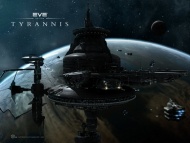
|
| Planetary Industry |
|---|
| Introduction to PI |
| The Basics |
| Advanced |
| Other Resources |
Planets are present in every solar system in New Eden and Anoikis, and the vast majority are uninhabited. There are nine types of planets in New Eden, though they do not appear with the same frequency. Shattered planets are the rarest type, as they are linked to specific historical events. Each planet type has a unique appearance that can be used to distinguish planets visually.
Planetary Industry introduced in the Tyrannis expansion allows players to colonize planets to extract various resources.
Colonization and commodities
- Main article: Planetary Commodities
Eight of the nine planet types support colonization. Colonies can produce five "tiers" of planetary commodities; the lowest tier, resources, are produced directly from the planet itself, while the other four (known as P1 through P4) are produced by combining resources in colony factories. Each planet type contains five different base resources, some of which are exclusive to a single type. Shattered planets do not produce resources and cannot be colonized.
Some planets cannot be colonized despite having a resource-producing type. These planets are either significant to the lore of New Eden or are located in systems with very heavy player traffic (Jita, for example).
Planet types
P1 products are produced directly from a single, specific resource, and can always be produced on the same planet that produces the associated resource.
P2 and P3 products that can be produced on a single planet without importing goods are also listed for each planet. Each planet type has exactly one P3 product it can produce without imports. All P4 products require products from multiple planet types, ranging from two to five. Products that can only be produced on one planet type without importing goods are highlighted in yellow.
Resources that appear exclusively on one planet type appear in green
Barren
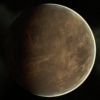
Barren planets are archetypical "dead terrestrials": dry, rocky worlds with a minimal atmosphere and an unremarkable composition. They are commonly etched with flood channels, which are often broad enough to be visible from orbit; most such worlds have accumulated significant quantities of ice over their lifetimes, but cannot retain it on their surface. Generally surface liquid evaporates rapidly, contributing to the thin atmosphere, but occasionally it will seep back into the ground and refreeze, ready for another breakout in the future when the local temperature rises.
- Resources
- Aqueous Liquids
- Base Metals
- Carbon Compounds
- Micro Organisms
- Noble Metals
Barren planets have three resources with little to no pattern in their distribution, and two with a more consistent pattern. Aqueous Liquids tend to be gathered near the poles in moderate to poor quantity, while Micro Organisms tend to cluster here and there in the "temperate" band (in Earth speak).
- Single-Planet Products
- Biocells
- Mechanical Parts
- Nanites
- Test Cultures
- Water-Cooled CPU
- Transcranial Microcontrollers (P3)
Gas
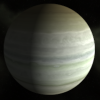
Gas planets are characterized by a deep, opaque upper atmosphere, usually composed primarily of light elements such as hydrogen or helium. Simple chemicals can add a range of hues and shades in the visual spectrum, and the interaction between upwellings and rapidly circulating pressure bands results in a huge variety of visible surface structures. A similar level of diversity can be found beneath the cloud-tops: the inner composition of a given gas planet might belong to any one of a dozen broad groups, with no two planets entirely alike.
- Resources
- Aqueous Liquids
- Base Metals
- Ionic Solutions
- Noble Gas
- Reactive Gas
Resources on a Gas planet will typically be found in narrow bands running east-west at various latitudes. Base metals are generally in bands around the equator, Aqueous Liquids, and Ionic Solutions in mid-latitudes bands, with the Noble Gas near the poles. Reactive Gas will be found in small pockets at all latitudes. Gas planets are normally larger than most other types of planets, so connecting links between structures will generally take more power grid and CPU.
- Single-Planet Products
- Coolant
- Oxides
- Synthetic Oil
- Water-Cooled CPU
- Condensates (P3)
Ice
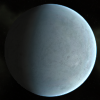
The majority of icy planets went through a period of being barren terrestrials, before being surfaced with ice over the course of many millennia. The exact process for this varies from case to case, but the end result is both common and visually uniform - a bright, reflective planet scored by countless fractures and crevasses. A few icy planets are hypothesized to have been warmer, liquid-bearing planets in the past that have subsequently frozen, as a result of either stellar cooling or failed terraforming projects.
- Resources
- Aqueous Liquids
- Heavy Metals
- Micro Organisms
- Noble Gas
- Planktic Colonies
Ice planets typically have high amounts of Heavy Metals and Aqueous Liquids available. Micro Organisms and Noble Gas are less abundant, with Planktic Colonies being somewhat thin. Aqueous Liquids tend to be found more in the polar regions of Ice planets, Planktic Colonies in the temperate latitudes, and Micro Organisms in the equatorial regions. Noble Gas and Heavy Metals are more randomly distributed with Heavy Metals more towards the equator and Noble Gas more towards the poles but with large areas of overlap and intermingling.
- Single-Planet Products
- Supertensile Plastics
- Test Cultures
- Viral Agent
- Synthetic Synapses (P3)
Lava
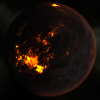
So-called "lava planets" (properly called "magmatic planets") fall into one of three groups: solar magmatics, which orbit sufficiently close to their star that the surface never cools enough to solidify; gravitational magmatics, which experience gravitational shifts sufficiently strong to regularly and significantly fracture cooling crusts; and magmatoids, which are for largely-unexplained reasons simply incapable of cooling and forming a persistent crust. All three types generally exhibit the same external phenomena - huge red-orange lava fields being a defining feature - but the latter two types are sometimes capable of briefly solidifying for a period measured in years or perhaps decades.
- Resources
- Base Metals
- Felsic Magma
- Heavy Metals
- Non-CS Crystals
- Suspended Plasma
Resources on Lava planets do not appear to follow any pattern trends and are scattered all over. You'd think the planet was all liquidy and floaty and stuff. Felsic Magma and Heavy Metals appear to follow the texture of where "lava" is on the planet surface. Inversely, Base Metals and Suspended Plasma seem to congregate where "lava" isn't rendered on the planet.
- Single-Planet Products
- Construction Blocks
- Consumer Electronics
- Miniature Electronics
- Transmitter
- Smartfab Units (P3)
Oceanic
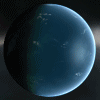
Oceanic worlds are a class of terrestrial world covered entirely by liquids, usually in the form of mundane water. While the liquid surface is exceptionally smooth, the ocean floor on most worlds of this type exhibits significant topographic variety. It is this subsurface irregularity that causes the formation of complex weather systems, which would otherwise revert to more uniform patterns.
- Resources
- Aqueous Liquids
- Carbon Compounds
- Complex Organisms
- Micro Organisms
- Planktic Colonies
Aqueous Liquids are obviously easy to find on Oceanic planets, likely increasing in intensity where depth is greater. Such focus points in abundance generally match peaks of Complex Organisms, while Micro Organisms are found in shallower water together with Carbon Compounds. Planktic Colonies, found only on Oceanic and Ice planets, float in bands around the temperate zone.
- Single-Planet Products
- Fertilizer
- Genetically Enhanced Livestock
- Livestock
- Test Cultures
- Viral Agent
- Vaccines (P3)
Plasma
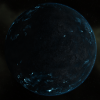
The aptly-named "plasma planets" have captured the imagination of countless artists and inspired innumerable works, yet the physics behind them are surprisingly mundane by cosmological standards. A rocky terrestrial with the right kind of atmosphere and magnetic field will, when bombarded with solar radiation, generate sprawling plasma storms as specific atmospheric elements are stripped of their electrons. Over time these storms will generally scorch the surface rock black, adding to the visual impact.
- Resources
- Base Metals
- Heavy Metals
- Noble Metals
- Non-CS Crystals
- Suspended Plasma
Resource distribution on Plasma planets generally follow the pattern of the whitish plasma "storms" visible on the surface. Base and Heavy Metals tend to be found in the darker spots on the planet, while Noble Metals and Suspended Plasma are found in the actively boiling areas. Non-CS Crystals are found mostly in the polar band, except the pole itself.
- Single-Planet Products
- Construction Blocks
- Consumer Electronics
- Enriched Uranium
- Mechanical Parts
- Transmitter
- Robotics (P3)
Storm
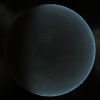
Storm worlds are usually considered terrestrial planets, although to a casual eye they may appear more similar to gas planets, given their opaque, high-pressure atmospheres. Geomorphically, however, the distinctions are clear: compared to a gas world, the atmosphere of a storm world is usually considerably shallower, and generally composed primarily of more complex chemicals, while the majority of the planet's mass is a rocky terrestrial ball. Their name is derived from the continent-scale electrical storms that invariably flash through their upper atmospheres.
- Resources
- Aqueous Liquids
- Base Metals
- Ionic Solutions
- Noble Gas
- Suspended Plasma
Storm planets tend to have equal amounts of Aqueous Liquids, Base Metals, and Suspended Plasma in decent amounts, with Noble Gas running a close 4th and Ionic Solutions as a distant 5th and somewhat sparse. Ionic Solutions tend to be distributed in the middle latitudes, Noble Gas anywhere but the equator, and Suspended Plasma tending towards the equatorial regions. Aqueous Liquids and Base Metals will appear on broad swaths across all latitudes in giant swirling patterns.
- Single-Planet Products
- Coolant
- Rocket Fuel
- Super Conductors
- Synthetic Oil
- Water-Cooled CPU
- Ukomi Super Conductors (P3)
Temperate
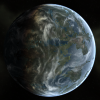
Life-bearing worlds are often referred to as "temperate", as their mild temperatures are one of their defining features. Planets with existing, stable ecosystems are prime targets for colonization efforts as they are generally easier to make fully habitable; as a result, the majority of highly populated worlds are of this type. Indeed, it is not altogether uncommon for detailed surveys to reveal signs of previous settlements from various stages of New Eden's history.
- Resources
- Aqueous Liquids
- Autotrophs
- Carbon Compounds
- Complex Organisms
- Micro Organisms
The physical appearance of these planets also has a high impact upon the resources available. Temperate planets with large amounts of water coverage will have an increased supply of Aqueous Liquids whilst having a reduced supply of Complex Organisms and Micro Organisms, planets with large amounts of land mass coverage show an increase in the supply of Micro Organism (and occasionally Complex Organisms) and a significantly reduced amount of Aqueous Liquids.
- Single-Planet Products
- Fertilizer
- Livestock
- Polytextiles
- Test Cultures
- Industrial Explosives (P3)
Shattered planets
Shattered worlds were once terrestrial planets, torn asunder by some immense cataclysm. All such worlds in the New Eden cluster are products of the disastrous stellar events that occurred during the "Seyllin Incident"[1]
Shattered planets can also be found in special shattered wormhole systems in wormhole space. How these planets came to be is unknown, though various player theories have been proposed.
Scorched Barren
Following the extreme stellar event of the Turnur system, the former barren planet Turnur I has been scorched by high-energy radiation with a complete loss of life and destruction of POCO and all colonies on it. It is no longer available to planetary industry.
Resource distribution by planet type
The fields in the above table highlighted in green are uniquely produced on that planet type.
Distribution of planet types
| Type | HiSec | LoSec | NullSec | W-Space | Total |
|---|---|---|---|---|---|
| 3042 | 1783 | 8485 | 6372 | 19,682 | |
| 3252 | 1711 | 8070 | 6101 | 19,134 | |
| 1222 | 607 | 2929 | 2242 | 7000 | |
| 916 | 570 | 2830 | 2089 | 6405 | |
| 772 | 499 | 2320 | 1796 | 5337 | |
| 482 | 289 | 1391 | 1072 | 3234 | |
| 459 | 284 | 1259 | 933 | 2935 | |
| 247 | 148 | 620 | 474 | 1489 | |
| Shattered | 0 | 1 | 6 | 2 | 9 |
| Scorched Barren | 0 | 1 | 0 | 0 | 1 |
See also
References
- ^ Lore info on the Seyllin Incident and locations of shattered planets.
